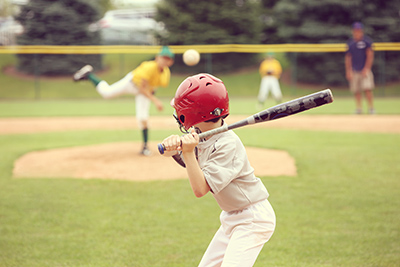Tips on how to avoid an eye injury during sports play
March 6, 2019
Eye injuries can happen quickly, and their painful effects can last a lifetime. According to the American Academy of Ophthalmology, every year in the U.S. more than 40,000 people suffer from eye injuries while participating in sports or other recreational activities. About half of those injuries – 19,000, according to the American Academy of Pediatrics – were children treated in the emergency department.

Whether you’re an adult or child, wearing eye protection should be part of an athlete’s preparation, just like putting on shin guards, gloves or a helmet. NCH Medical Group Family Medicine Physician David Pohl, D.O. answers questions about eye injuries and includes tips on how to prevent and protect your peepers during sports play this spring.
What types of sports/games put us at risk for eye injuries?
The most common sports for eye injuries are baseball and softball. Basketball, racquetball, football and soccer are also at the top of the list. Any sport that uses a projectile or held object like a ball, tennis racquet or hockey stick has the potential for an eye injury. Anything where there is direct contact to the face, like boxing, wrestling and football, even though people are wearing helmets, puts them at risk for eye injuries.
Why do we see so many eye injuries among children?
As they’re growing up, kids are developing their hand-eye coordination and depth perception. Since they have poorer coordination than adults, they may be trying to catch a fly ball with a mitt, for example, and misjudge the distance so the ball hits them in the face. Also, during sports play, teammates or opponents can easily lose control of their equipment, like a hockey player whose stick flies up.
Kids grow at different rates, too. A lot of times, one kid may be more developed than another on that same or opposing team. He or she may be stronger and more coordinated. As that strength and coordination improves, so does their intensity in the game. They can kick, throw or hit harder, and that leads to greater impact and trauma, especially for the head and face.

What are some common eye injuries related to sports?
The most common would be a scratch on the eye or a foreign body, which is called a corneal abrasion. It could be dirt or grass flying into the eye. This is relatively the simplest kind of eye injury to treat. We’re able to get the foreign body out, control the pain with medication and use antibiotic eye drops to prevent an infection. The next category is blunt trauma. This would be caused by a ball or a stick or some other player that causes a forceful impact on the eye, the brow or the cheek. Any eye injury should be evaluated by a medical professional, so if we determine that specialty care is needed, we would refer the patient to an ophthalmologist. Things like a ruptured eyeball, detached retina or a fracture of the facial bones should be seen in the emergency department and would likely require further treatment by an ophthalmologist.
Are kids who wear glasses already protecting their eyes?
No, regular glasses do not provide adequate eye protection for sports, especially on the sides. They can also cause more damage or injury if they should break or shatter. Depending on what sport they’re playing and what the typical recommendation for eyewear would be, they should look into getting prescription sports-related eyewear. There are impact-resistant lenses and frames that significantly can reduce the risk of a serious eye injury. If someone wears glasses, they can get protective lenses in their prescription. Participants should really look at the specific sport and consider the recommended eyewear protection.
How can we protect our eyes from injuries during sports?
Wear the recommended protective gear for whatever sport that you’re in, and take your own needs into consideration. If you wear glasses, switch to protective eyewear during activity. For football, you might want to look into a protective shield for your helmet because there’s a big opening where hands and elbows still can get inside. Going above and beyond normal equipment recommendations additionally can help protect your eyes.
Can you describe treatment for a patient with an eye injury?
Any eye injury should be evaluated by a medical professional/ophthalmologist. We first take a history to determine the type of trauma. We perform an eye exam to look at vision and movement of the eyeballs, check the cornea for scratches or abrasions, and look at the back of the eye for any issues. Depending on what we find, we often can treat it immediately.
With spring coming, what are some safe-play tips for preventing eye injuries in children and adults?
My safe-play tips would be to know the sport and protect your eyes accordingly. Parents should set a good example for their kids. Even if you’re just playing catch in the yard, put on protective eyewear. Encourage both parents and kids to play fair. Always play by the rules because they’re there for the safety of the athletes and the spectators.
Dr. David Pohl specializes in Family Medicine and Sports Medicine. His clinical interests are sports injuries, including concussion. He practices at 1450 Busch Parkway, Suite 100, in Buffalo Grove. Call 847-459-7860 to schedule an appointment. Watch this YouTube video to learn more about Dr. Pohl and find out what you can expect in a typical visit.